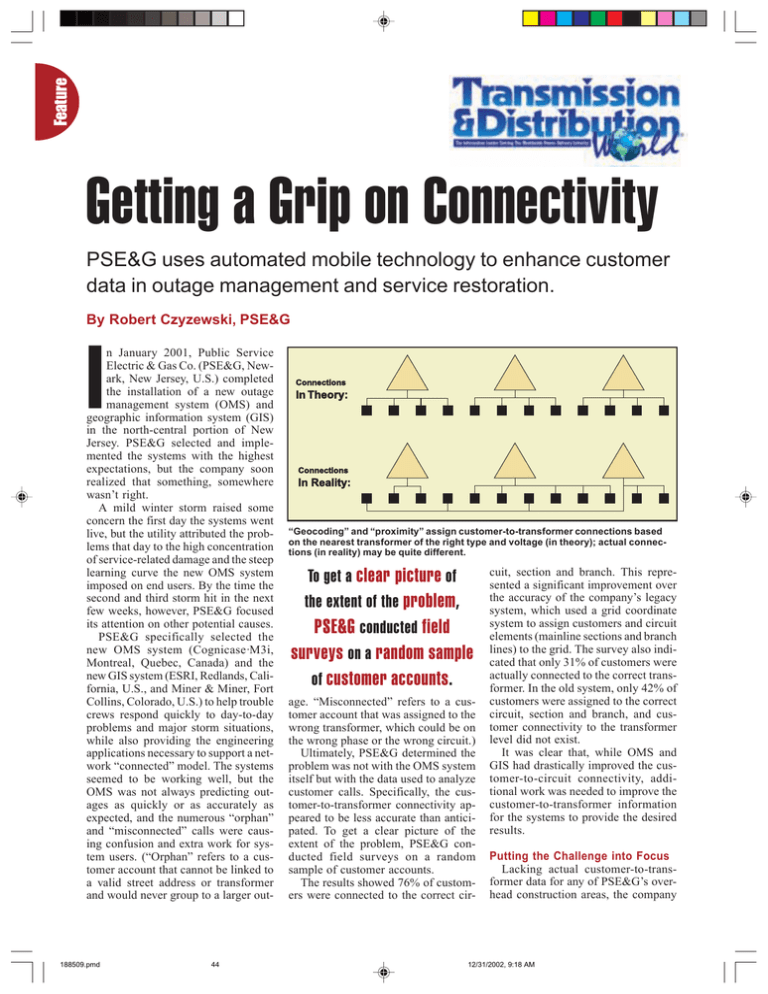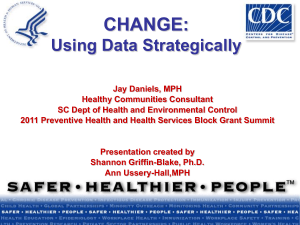
Getting a Grip on Connectivity
PSE&G uses automated mobile technology to enhance customer
data in outage management and service restoration.
By Robert Czyzewski, PSE&G
I
n January 2001, Public Service
Electric & Gas Co. (PSE&G, Newark, New Jersey, U.S.) completed
the installation of a new outage
management system (OMS) and
geographic information system (GIS)
in the north-central portion of New
Jersey. PSE&G selected and implemented the systems with the highest
expectations, but the company soon
realized that something, somewhere
wasn’t right.
A mild winter storm raised some
concern the first day the systems went
live, but the utility attributed the problems that day to the high concentration
of service-related damage and the steep
learning curve the new OMS system
imposed on end users. By the time the
second and third storm hit in the next
few weeks, however, PSE&G focused
its attention on other potential causes.
PSE&G specifically selected the
new OMS system (Cognicase·M3i,
Montreal, Quebec, Canada) and the
new GIS system (ESRI, Redlands, California, U.S., and Miner & Miner, Fort
Collins, Colorado, U.S.) to help trouble
crews respond quickly to day-to-day
problems and major storm situations,
while also providing the engineering
applications necessary to support a network “connected” model. The systems
seemed to be working well, but the
OMS was not always predicting outages as quickly or as accurately as
expected, and the numerous “orphan”
and “misconnected” calls were causing confusion and extra work for system users. (“Orphan” refers to a customer account that cannot be linked to
a valid street address or transformer
and would never group to a larger out-
188509.pmd
44
Connections
In Theory:
Connections
In Reality:
“Geocoding” and “proximity” assign customer-to-transformer connections based
on the nearest transformer of the right type and voltage (in theory); actual connections (in reality) may be quite different.
To get a clear picture of
the extent of the problem ,
PSE&G conducted field
surveys on a random sample
of customer accounts .
age. “Misconnected” refers to a customer account that was assigned to the
wrong transformer, which could be on
the wrong phase or the wrong circuit.)
Ultimately, PSE&G determined the
problem was not with the OMS system
itself but with the data used to analyze
customer calls. Specifically, the customer-to-transformer connectivity appeared to be less accurate than anticipated. To get a clear picture of the
extent of the problem, PSE&G conducted field surveys on a random
sample of customer accounts.
The results showed 76% of customers were connected to the correct cir-
cuit, section and branch. This represented a significant improvement over
the accuracy of the company’s legacy
system, which used a grid coordinate
system to assign customers and circuit
elements (mainline sections and branch
lines) to the grid. The survey also indicated that only 31% of customers were
actually connected to the correct transformer. In the old system, only 42% of
customers were assigned to the correct
circuit, section and branch, and customer connectivity to the transformer
level did not exist.
It was clear that, while OMS and
GIS had drastically improved the customer-to-circuit connectivity, additional work was needed to improve the
customer-to-transformer information
for the systems to provide the desired
results.
Putting the Challenge into Focus
Lacking actual customer-to-transformer data for any of PSE&G’s overhead construction areas, the company
12/31/2002, 9:18 AM
Automating the Field-Collection Process
The FastGate Mobile approach PSE&G selected helped automate the datacollection (and eventually the data-maintenance) process. The strategy (see
figure below) involved the following steps:
● Access source data from PSE&G’s ArcGIS and Meter Data Repository
(MDR) databases.
● Create work packages for GPS-fitted PocketPC handhelds equipped with
FastGate Mobile software configured to collect data specific to PSE&G’s requirements.
● Capture customer-to-transformer connections and targeted facility data in the
field using integrated geospatial and customer data.
● Conduct QA/QC and data-validation processes on sample data using the
handheld device to identify any potential data problems.
● Import updated and corrected data from FastGate Mobile to the FastGate
processing environment for data validation, automated creation of connectivity,
and detection and correction of data errors.
● Upload corrected data into GIS and OMS databases. Conduct final data
checks and QA/QC on OMS data.
was faced with some tough decisions
at the outset of the OMS/GIS project.
It was important to get the new systems running quickly in order to satisfy regulatory requirements and to
abide by the recommendations of the
company’s own internal studies.
So to meet the time constraints, the
company decided to pursue an automated means of creating customer-totransformer connectivity. PSE&G
would use transformer-proximity techniques and geocoding to ensure reasonably accurate connectivity. In essence, customers are assigned to the
nearest transformer that have the correct phase and voltage.
Although this approach provides a
timely way to create connectivity, it
understandably is not as accurate as
the data a comprehensive field survey
provides. The project team and the GIS
vendor knew, however, that the approach would provide reasonable and
functional results.
Some degree of error is to be expected in the geocoding process. Most
geographic data sets, for example, assume that addresses are evenly spaced
between street intersections; however,
this is not always the case in the real
world. Problems also arise as a result
of obstacles and physical constraints
that sometimes require construction
crews to connect customers to transformers that are the closest choice. Finally, typographical errors or inconsistencies in the way addresses are
entered in the Customer Information
System (CIS) can cause customer accounts to be missed entirely by the
geocoding process. For example,
people can distinguish between “1st
Street” and “First Street,” but comput-
188509p2.pmd
45
ers require a standard of consistency.
A Second Pass at Connectivity
While the geocode and proximity
approach came with compromises, both
systems were successfully implemented within very tight time constraints. The company knew, however,
that a labor-intensive field survey ultimately would be required to allow the
OMS system to perform to its full capabilities. A second pass at customer
connectivity was planned to immediately follow the system rollout as the
single best way to resolve the issue.
PSE&G published a project scope
document that outlined the basic requirements of a field audit. The four
key objectives included:
● Improve the customer-to-transformer connectivity to an accuracy
level of 96% or better.
● Focus on areas with the most outages and the largest number of customer errors.
● Institute a maintenance process
to ensure the ongoing accuracy of the
data.
● Reconcile transformer and pole
data per the customer survey.
Meeting these objectives would significantly improve the accuracy and
responsiveness of the company’s OMS
system, while also reducing the manual
workload of the system’s end users.
It was generally acknowledged that
PSE&G’s network (circuit) connectivity down to the transformer level was
good. As such, the main focus of the
field survey was to correct the link
from the transformer to the customer.
Errors in facility information would
only be captured and reported on an
exception basis as the field survey team
found discrepancies.
Selecting a Solution
Accuracy was key to the overall success of the cleanup effort. To be sure
that the successful vendor could deliver the customer connectivity with at
least 96% accuracy, the project scope
included a small 5000-customer pilot
area. At the conclusion of the pilot,
several of the participating companies
The FastGate Mobile approach allowed fast, automated data collection and data
maintenance.
12/31/2002, 9:03 AM
were able to demonstrate the accuracy
of their approach, but only one could
provide a turnkey solution at the desired price point in the time frame
needed.
The solution from Osmose Utilities
Services (Buffalo, New York, U.S.)
included the use of the company’s
FastGate data-integration software to
access and combine GIS and meter-reading data. The data is then downloaded
to PocketPC devices fitted with GPS
receivers. Osmose field crews would
utilize the FastGate Mobile application and the geospatial data from
ArcGIS in combination with PSE&G’s
meter-sequence route information to
complete the field survey. The FastGate
Mobile software provided detailed map
data and customer information to field
crews so that customer-to-transformer
connections (as well as other targeted
facilities data) could be added, deleted,
and/or verified on the spot. The approach streamlined the data-collection
process and eliminated the need for
hardcopy. Only a small subset of the
field survey data required manual data
entry, owing mostly to versioning requirements of the GIS system.
PSE&G intends to use the FastGate
Mobile software to automate the quality assurance/quality control (QA/QC)
and data maintenance process. The
same features that made FastGate useful for the data-collection phase of the
project—automated download, embedded data validation, and the near elimination of manual data entry—also are
expected to provide PSE&G with significant cost savings in the acceptance
and ongoing maintenance of the data.
The ability to use handheld field devices was an important consideration.
Laptop computers are expensive and
difficult to manage in an environment
where “walking” surveys may be required. By comparison, the small
PocketPC devices are compact and
relatively inexpensive, but still provide
adequate functionality to support fieldbased data collection.
For PSE&G’s purposes, the FastGate
Mobile approach offered a flexible,
economical and feasible solution. It
was configurable, allowing for simple
CIS information is integrated with geospatial landbase and facility data from
the GIS.
changes in process and data collection
requirements. It also was easy to learn
and easy to use. Finally, it ran on an
inexpensive off-the-shelf Compaq
iPAQ PocketPC device rather than a
more expensive and cumbersome
laptop computer.
An 18-Month Initiative
In January 2002, Osmose completed
the first phase of the project, involving
45,000 customers from PSE&G’s southern division area. The purpose of this
phase was to prove the proper operation of the software and work the kinks
out of the various data exchanges before moving on to the large-scale effort.
The full-scale survey work began
March 2002 and focused on those areas within PSE&G’s territory with
the largest number of circuit outages
and the worst customer connectivity.
Field survey work will continue until
the project is completed in mid-2003,
and will include all of PSE&G’s 1.5
million overhead customers.
Lessons Learned
One of the key lessons of PSE&G’s
OMS/GIS project is that the importance
of data quality can never be overestimated. While the use of sophisticated
customer connectivity algorithms
vastly improved the data quality over
the legacy system, further cleanup was
needed for both systems to deliver their
full potential.
It is also important to think long
term when it comes to investing in
major systems and the data that supports them. In the case of OMS and GIS
systems, connectivity data typically
will change slowly but continuously
over time. Therefore, there needs to be
a commitment to the ongoing maintenance and management of the data,
even after a bulk cleanup effort
is complete. Companies making substantial investment in such systems
must also be willing to make the necessary investments in training and tools
to ensure the data stays accurate over
time.
It is especially important to structure a data maintenance program so
that it fits well in the company’s larger
business processes and systems. This
can be a significant challenge, especially in the midst of a new technology
deployment that relies on data that
was not necessarily maintained in the
past. Introducing new technologies and
new data-collection requirements at
the same time requires patience, continuous monitoring, and follow-up.
The solution PSE&G selected works
well, because it provides an appropriate solution to a potentially timedemanding and large resource-consuming problem. It also works because
of the company’s growing awareness
that accurate data is as important
as sophisticated software. Technical
solutions may be elegant and important, but without a commitment to
accurate data, the value of most major
technology investments can not be fully
realized. ◗
Bob Czyzewski holds a BS degree from
the U.S. Merchant Marine Academy and
an MBA degree from Temple University.
As project lead in the business systems
group, he is responsible for the
conceptualization, justification, design and
deployment of major computer applications. Previously, Czyzewski served as
co-project manager for the company’s first
Automated Work Management System
(AWMS) and project lead for the OMS
component of the system.
Reprinted with permission from the October 2002 issue of Transmission & Distribution World.®
Copyright 2002, PRIMEDIA Business Magazines & Media Inc. All rights reserved. TD-29-CW
188509p3.pmd
46
1/10/2003, 9:07 AM
Osmose Utilities Services, Inc.
980 Ellicott Street
Buffalo, NY 14209
800-877-7653
www.osmose.com
188509p4.pmd
47
12/26/2002, 11:46 AM



